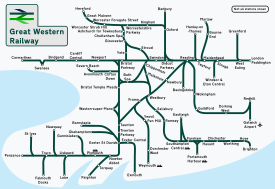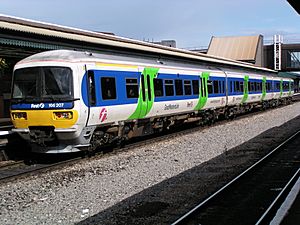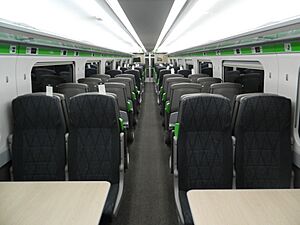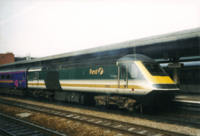Great Western Railway (train operating company) facts for kids
| Info | |||
|---|---|---|---|
| Franchise(s): |
|
||
| Main {{{nameforarea}}}(s): | |||
| Other {{{nameforarea}}}(s): | |||
| Fleet size: | |||
| Stations called at: | over 270 | ||
| Stations operated: | 199 | ||
| National Rail abbreviation: | GW | ||
| Parent company: | FirstGroup | ||
| Technical | |||
| Gauge: | 1,435 mm (4 ft 8 1⁄2 in) standard gauge | ||
| Electrification: |
|
||
|
|||
Great Western Railway (GWR) is a train company in the United Kingdom. It is owned by FirstGroup. GWR runs trains across a large area, including London, the West of England, and South Wales.
The company manages 197 train stations and its trains stop at over 270 places. GWR operates long-distance trains, local services, and even a special overnight sleeper train called the Night Riviera. It also runs the Heathrow Express service to Heathrow Airport.
GWR started in February 1996 as Great Western Trains. In 1998, it became First Great Western. Later, in 2006, it joined with two other train companies, First Great Western Link and Wessex Trains, to form a bigger company under the First Great Western name. The company changed its name to Great Western Railway in September 2015. It also got a new green look for its trains, like the old Great Western Railway that ran trains a long time ago.
Contents
How GWR Started and Grew
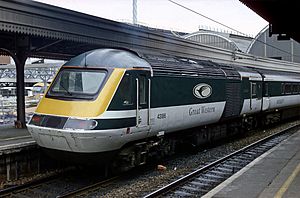
When British Rail, the national train company, was split up into many smaller private companies, the Great Western train services were given to a group called Great Western Holdings in 1995. They started running trains on February 4, 1996.
In 1998, FirstGroup bought all the shares in Great Western Holdings. This made FirstGroup the full owner. In December 1998, the company changed its name to First Great Western.
On April 1, 2004, another company called First Great Western Link started running local services from London Paddington to places like Oxford and Reading. It also ran trains from Reading to Gatwick Airport.
Then, on April 1, 2006, the Great Western, Great Western Link, and Wessex Trains companies all joined together. This created a new, larger Greater Western franchise. FirstGroup won the bid to run this new, bigger train service. They decided to keep the name 'First Great Western' for all their services.
In 2011, FirstGroup decided not to extend their contract. They wanted to make a new, longer deal because of big plans to add electric lines to the Great Western route. This project cost a lot of money, and FirstGroup wanted to be in charge of it for a longer time.
The government then looked for new companies to run the franchise. However, the process was delayed several times. In January 2013, the government stopped the competition. FirstGroup's contract was extended until October 2013, then again until September 2015, and finally until March 2019.
In March 2015, the contract was extended one more time until April 2019.
In 2014, the first-class train carriages were updated. They had a new GWR logo, without the "First" brand. On September 20, 2015, the whole company officially changed its name to Great Western Railway (GWR). They also introduced a new dark green color for their trains, which was a nod to the original Great Western Railway that ran trains from 1835 to 1947.
In May 2018, another train service, TfL Rail (now called the Elizabeth line), took over some services from Paddington to Hayes & Harlington and Reading.
In March 2020, the government extended GWR's contract until March 31, 2023. In June 2022, the government changed the agreement to a direct contract that will last until June 25, 2028. There is also an option to extend it for another three years.
GWR was one of the train companies affected by the 2022–2024 United Kingdom railway strikes. These were the first big national train strikes in the UK in 30 years.
Where GWR Trains Go
Great Western Railway runs trains to many places west of London. These include areas like Wiltshire, Bristol, Cornwall, Gloucestershire, Oxfordshire, Berkshire, Hereford, and South Wales.
Here are some of the main routes GWR trains take:
Long-Distance Journeys
GWR runs many long-distance trains, connecting London to major cities and regions.
- London to South Wales: Trains go from London Paddington to Cardiff Central and Swansea. Some even continue to Carmarthen.
- London to Bristol and Somerset: Services run from London Paddington to Bristol Temple Meads. Some trains go further to Weston-super-Mare.
- London to Devon and Cornwall: Trains travel from London Paddington to places like Exeter St Davids, Plymouth, and Penzance. These services help people reach the beautiful South West coast.
- London to Oxford and The Cotswolds: GWR trains connect London Paddington to Oxford and beyond, reaching places like Great Malvern and Cheltenham Spa.
Local and Regional Routes
GWR also operates many shorter, local routes.
- Thames Valley Area: Trains run from London Paddington to Didcot Parkway and Newbury. There are also services on smaller branch lines like the Greenford branch line and the Marlow branch line.
- Bristol Area: Services connect Cardiff Central to Portsmouth Harbour, and Bristol Temple Meads to places like Severn Beach and Weymouth.
- West of England: In the far west, GWR runs trains on lines like the Cornish Mainline (from Plymouth to Penzance), the Avocet Line (from Exmouth to Paignton), and the Tarka Line (from Exeter Central to Barnstaple).
Special Named Trains
GWR has several trains with special names, often linked to the places they travel through. These names are a bit like nicknames for specific services.
- The Armada (Plymouth to London Paddington)
- The Bristolian (London Paddington to Bristol Temple Meads)
- The Cornishman (Penzance to London Paddington)
- The Night Riviera (London Paddington to Penzance) - This is GWR's famous overnight sleeper train.
- The Red Dragon (London Paddington to Carmarthen)
What's Inside the Trains?
GWR offers different services on board its trains.
First Class Travel
First class is available on all long-distance, high-speed trains. In first class on the newer IET trains, you'll find comfy reclining seats with tables. A customer host often provides service right to your seat. There are power sockets and USB charging points at every seat, plus upgraded Wi-Fi.
Standard Class Travel
Standard class is on all GWR trains. On many long-distance and regional routes, you can reserve a specific seat.
Food and Drink Service
On most IET services, there's a trolley service where you can buy snacks and drinks right at your seat. Some special long-distance trains also have a restaurant car where you can buy meals.
Train Performance and Challenges
GWR, like any big train company, sometimes faces challenges.
Helping Disabled Passengers
In 2018, there was an incident where a disabled woman felt upset by GWR staff because she was using a space for her mobility scooter. GWR said this should not have happened and that no one should feel that way when traveling with them.
Train Strikes
In 2015, there were strikes by the RMT union because of new trains. The union was worried about who would control the train doors. After talks, GWR agreed to keep conductors on all new IET services. There were also strikes in 2016 and 2017 by cleaners who wanted better pay and working conditions. These issues were later resolved.
Train Cracks (IET Issues)

In April 2021, small cracks were found on parts of the suspension system of some new Class 800 and Class 802 InterCity Express Trains (IETs). Because of this, many of these trains had to be taken out of service for safety checks. This caused big delays and changes to GWR's long-distance services. Other types of trains, like the Class 387 units, were used to help cover the routes. More inspections were done, and trains slowly returned to service.
Types of Trains GWR Uses
GWR uses many different types of trains for its services.
Inter-City Trains
- Class 800 and 802 Intercity Express Trains (IET): These are GWR's newest long-distance trains. They are used for most journeys between London and places like Bristol, Cardiff, Swansea, and Penzance. The Class 802 trains are very similar to the Class 800s but have stronger engines and bigger fuel tanks for the long, non-electric parts of the journey to Devon and Cornwall.
Sleeper Trains
- Class 57 Locomotives + Mark 3 Coaches: These trains are used for the Night Riviera sleeper service between London and Penzance. The Class 57 locomotives pull special Mark 3 coaches where passengers can sleep overnight.
Thames Valley and Bristol Trains
- Class 165 and 166 Networker Turbo: These are diesel trains used for shorter journeys in the Thames Valley area (around Reading and Oxford) and in the Bristol area. They are used on many local lines and some longer regional routes.
- Class 387 Electrostar: These are electric trains used on routes from London Paddington to places like Didcot Parkway and Newbury. They are modern trains with Wi-Fi and power sockets. Some of these trains are also used for the Heathrow Express service.
West of England Trains
- Class 43 + Mark 3 HST / Class 255 Castle: GWR still uses some of its older, but refurbished, High Speed Trains (HSTs). These are called 'Castle' sets and are used on services between Plymouth and Penzance. They are being updated with automatic doors.
- Class 150/2 Sprinter: These two-coach diesel trains are used on many local lines in the West of England, especially in Devon and Cornwall, like the Avocet Line and Looe Valley Line.
- Class 158 Express Sprinter: These diesel trains are used for regional express services. They have been refurbished with new seats and lighting. They are used on routes like Cardiff to Portsmouth Harbour and in the Bristol and West of England areas.
Future Trains
GWR is always looking to improve its fleet.
- Class 175: GWR plans to start using Class 175 trains in 2025. These diesel trains will be used on routes in the West of England, including services to Penzance and Barnstaple.
- Class 230: GWR bought some parts from a company called Vivarail and plans to test a special battery-powered Class 230 train on the Greenford branch line.
Trains No Longer Used
Over the years, GWR has used and then stopped using several types of trains, including:
- Class 142 and 143 Pacer: These older, simpler diesel trains were used in Devon and Cornwall but were replaced by newer trains.
- Class 150/0 and 150/1 Sprinter: Some older Class 150 units were transferred to other train companies.
- Class 153 Super Sprinter: These single-coach diesel trains were also moved to other operators.
- Class 43 (HST) and Mark 3 Coaches: Most of the original InterCity 125 HST fleet was replaced by the new IET trains by 2019.
- Class 180 Adelante: These diesel trains were used for intercity services but were later transferred to another company.
- Class 769: GWR had planned to use these special trains that could run on both electric and diesel power, but decided not to in 2022 due to reliability issues.
Train Colors and Look
GWR trains have changed their look over the years.
When it was Great Western Trains, the trains were dark green on top and ivory on the bottom, with a special 'Merlin' bird logo. When it became First Great Western, they added gold and pink stripes.
The new Class 180 trains had a purple-blue color with pink and gold stripes. Over time, other trains were painted to match this look.
When the company became Great Western Railway in 2015, they introduced a new dark green color with white stripes and grey doors. This new look is a tribute to the original Great Western Railway.
Train Homes (Depots)
GWR trains are kept and maintained at eight main depots. Older depots like Old Oak Common in London and Landore in Swansea closed in 2018.
- North Pole (London Paddington)
- Reading
- Stoke Gifford (Bristol Parkway)
- St Phillip's Marsh (Bristol Temple Meads)
- Exeter (Exeter St Davids)
- Laira (Plymouth)
- Long Rock (Penzance)
- Swansea Maliphant (Swansea)
TV Shows About GWR
Channel 5 has shown TV series about the daily life and challenges on the Great Western mainline. These shows covered events like problems at Dawlish (where the sea wall was damaged) and busy race days. The last series about The Railway: First Great Western aired in 2015. A similar show about London Paddington started in 2017.
What's Next for GWR?
GWR's current contract to run trains will last until June 25, 2028. There is also a chance it could be extended for another three years after that.
See also
 In Spanish: Great Western Railway (operador ferroviario) para niños
In Spanish: Great Western Railway (operador ferroviario) para niños
- Great Western Railway, the original railway company that existed from 1833 to 1948
- Western Region of British Railways


